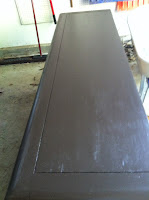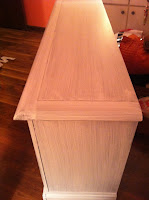It's the start of a new year, you're in the middle of painting and a million other projects, what should you do? Tear up old tile in a foyer and re-tile even though you've never done it before!
While in Home Depot wandering for other items we looked at the tile and suddenly decided, "why not?" We already knew the general square footage of the room so we were able to determine how much we would need. We checked both Home Depot and Lowe's for tile before realizing Home Depot had better prices for what we were looking for.
The old tile wasn't terrible, but it did look dirty to me and the grout was very stained. Even after several great scrubbings it still had some nicotine stain and just didn't feel fresh. It's one of the few areas in the house we hadn't touched.
The first step is to tear up the old tile. Remove all the base trim and the vents, and closet doors if you have them. We didn't have a sledge hammer, which would have been beneficial so we took hammers, screwdrivers, and a crow bar to the floor. We first tried to tear up the grout to get to the tile, then just gave in and beat the crap out of the tile with the hammers. Once we were able to get open areas we were able to take the crowbar (my favorite tool) and lift up large pieces. You also have to remove the concrete board under the tile and the screws that hold the concrete board down. This process takes a lot longer than you would think, requires a lot of effort, and makes quite a dusty mess.
Close the doors to your other rooms!! And wear a face mask!!! Lessons learned.
The next step is to make sure you have everything you need for the tile. The worker at Home Depot was really helpful. She was able to tell us everything we needed. You will need:
Hardibacker
Sponges (get several, for cleaning and de-hazing)
Tile
Float
Mortar
Mesh Joint tape
Mixing bucket
Trowel
A tile saw or cutter (We used both a scorer/snapper and a wet saw)
Electric drill
Hardibacker screws
Sealer
Grout (sanded or non-sanded; depends on your grout line size)
Grout bags
Spacers
You can see the sub-floor here as we started laying hardibacker. After you get to the sub floor make sure it's nice and clean and smooth. Then use hardibacker or a concrete base. You need this so that the tile will adhere and to level out the floor. We chose hardibacker because it has grids and is nice and sturdy. You will find a thin and a thick version at your home improvement store. The thin version is for flooring. This cost about $10 a piece. You can snap it into pieces that you need and you are supposed to leave a small space in between each piece and the walls. (Kyle really did all of this work).
You first mortar the hardibacker down and then screw it to the sub floor with special screws. (You can find these right by the hardibacker generally). Make sure you get the screws down in enough so that your tile will be level.
After you lay the hardibacker you will use the mortar and a special mesh joint "tape" and go over each crack in between the hardibacker pieces. Make sure to fill in any larger gaps with the mortar for tile support. The mortar starts to settle so make sure you use enough. You can get more in the tape when you lay the tile. You should let the mortar dry with the hardibacker for about a day before doing the next steps. (It took us about a month and half to finish this project so we really had no problems letting things cure).
Next comes the fun part of laying your tile. Decide what pattern you want. We laid the tiles out first before putting any mortar down to decide what pattern we wanted. We decided to go with an unaligned/off set pattern. We also decided to add in an accent. (Granted this was all decided when we were in the store well ahead of time).


We first put down all the tiles that did not need cut or scored. We started on one end and worked down. We decided ahead of time where the accents would make the most sense. The accents came in 12 x 12 pieces. We cut them in strips of 3's and 2's. To lay the tile first put down a coat of mortar. Use more than you think you need, this is something we learned as we had to go back and re-mortar a few pieces. Don't be stingy! Smooth the mortar out (work in small sections at a time). Score the mortar by running the trowel using the teeth side at a 45 degree angle. Lay your tile and use the spacers to make sure you have consistent spacing. We did one row at a time and decided how we wanted to stagger the pieces as we went. After we had all of the big pieces down we went in and cut the pieces that needed fit in. We measured the pieces and marked with a pencil. The bigger easy cuts we did using a scoring/snap saw (you can get it for about $20).

To use this tool you have to be careful. Make sure you have everything lined up. Use consistent pressure to score the tile. When you get to the end make sure the presser piece (the part that snaps it) is right on the break line on the end. Press firmly but not too hard or you will break the whole tile. I found I was a bit better at this than Kyle because he would have a tendency to push to hard. (Nothing against him, he did the hardibacker well). This tool is not good for cutting off small pieces or doing corners but is good for taking several inches off.

We used a wet saw to cut the smaller pieces and to do the corner pieces (luckily we could borrow one from my dad, as they aren't super cheap).
And yes, I cut it in the bathtub, because this thing makes a mess. But it's a great tool and pretty easy to use.
After you have all your tile down and spaced appropriately let the mortar dry. When you are mortaring you may have to build up a few places if the flooring isn't exactly level. We had a few places that had humps (mainly near the closet).
The mortar needs to dry for about a day.
The next part is to do the grout. If you have a porous, unsealed tile you may need to seal it first to protect from grout stain. We had a porcelain tile that was pretty non-porous so we didn't have to do this step. Follow the directions on the grout bag and mix just little bits at a time. I used a grout bag and a the float. Take out all the spacers. Then take your grout bag and fill it to a level you can manage with grout that has a consistency of toothpaste. Put the grout through the empty grout lines. Then smooth it out with the float. If there is extra on the float put it in an empty grout space. Don't be worried about making too much of a mess because you can clean it up. After the grout is down for about thirty minutes you can carefully clean off the excess grout with a damp sponge, just watch the grout in the lines (follow your bag instructions). Grouting really didn't take that long and was one of the more enjoyable parts.


After you wipe with a damp sponge you will still see this haze from the grout. At about two hours you can remove the haze with a dry sponge. I used one with a special microfiber side. Just wipe over the tiles. Also make sure at this time you clean up grout going too far over tiles and check your corners.
Grout takes about 16 hours to dry. The last step is to make sure your tile is very clean and seal it. I first wiped it down with a wet sponge, then after that dried swept it lightly. I could still feel some grit so I used a microfiber towel to wipe it off as I started the sealing process.
We used a spray sealer. You spray it generously over the tiles and grout and then spread it with a sponge. (Test this first to make sure it isn't going to change the color of your tile or grout, I tested the closet first). After five minutes, wipe of the excess sealant with a dry cloth or sponge. Let the sealant dry for 2-3 hours. If you have a porous surface you may have to do a second coat. Once the sealant is dry you are good to go.


Of course one project leads to another. We went to put the trim back up and realized it didn't look as great as we'd like.....







































